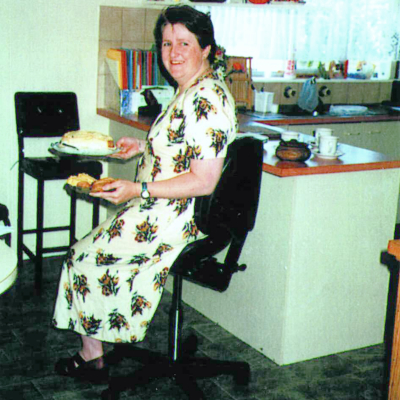
Ruth using crutches, attempting to perform kitchen tasks. It is obviously very difficult, with a high casualty rate for plates and a high stress level for Ruth and her family. Cooking this way was dangerous as well as extremely difficult.
Trauma to her right leg due to a motorbike accident in 1995 resulted in an above-knee amputation for Ruth. With a continuing series of unsatisfactory prostheses, Ruth was only mobile using two crutches. Standing for any length of time was impossible; carrying anything, or moving things around the house, was a logistical exercise. All her usual tasks in caring for a husband and three school children, as well as returning to work, were difficult or impossible.
As part of her return to work rehabilitation program, Ruth was offered a range of work stools. Only one was successful – the Bambach Saddle Seat supplied on loan by an occupational therapist.
Using the Bambach Saddle Seat, Ruth could work, as she could now get close to the counter. But her family life was so difficult she left work and took the Saddle Seat home, where it made a great difference. Ruth now has independence and mobility around the kitchen. She can prepare meals, move items around the kitchen and onto the table without having to ask for help. Even removing a roast from the oven is quite safe using the Bambach Saddle Seat.
The resulting independence is extremely important to Ruth. She has a prosthesis, and even though this is quite satisfactorily fitted, it is a relief to remove it at times, or to get a few things done before putting it on. When Ruth was in Sydney for the fitting of a new limb, she was so lost without the Bambach Saddle Seat that she hired one from the company for her six week stay.
A further benefit for Ruth is the fact that, when sitting on the Bambach Saddle Seat, her stump is not in 900 continuous flexion as it is in a wheelchair or conventional seat. This prevents the flexion contraction, which can often prevent successful use of a prosthesis.